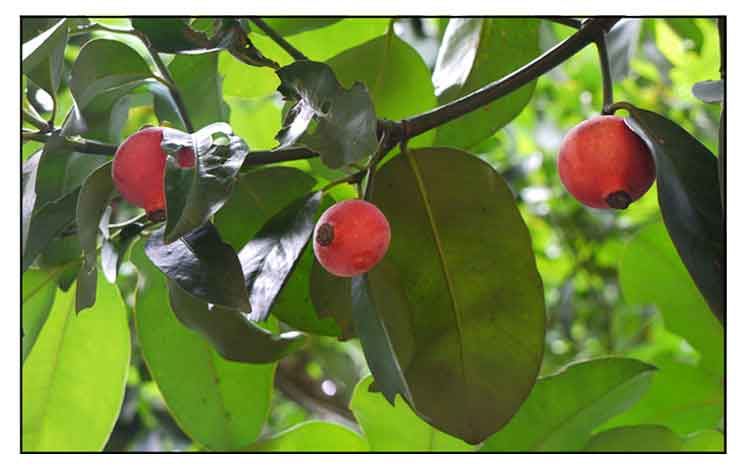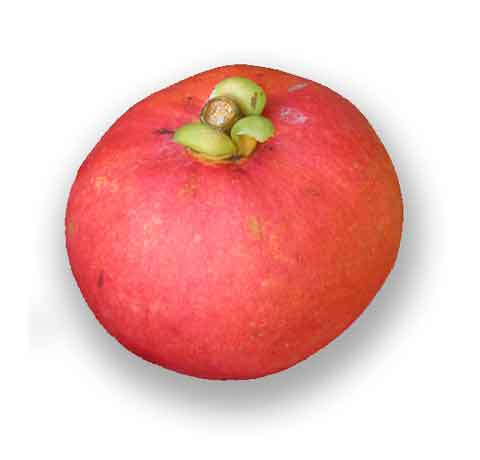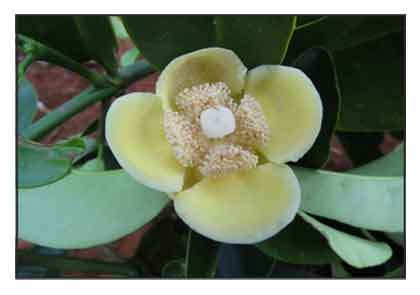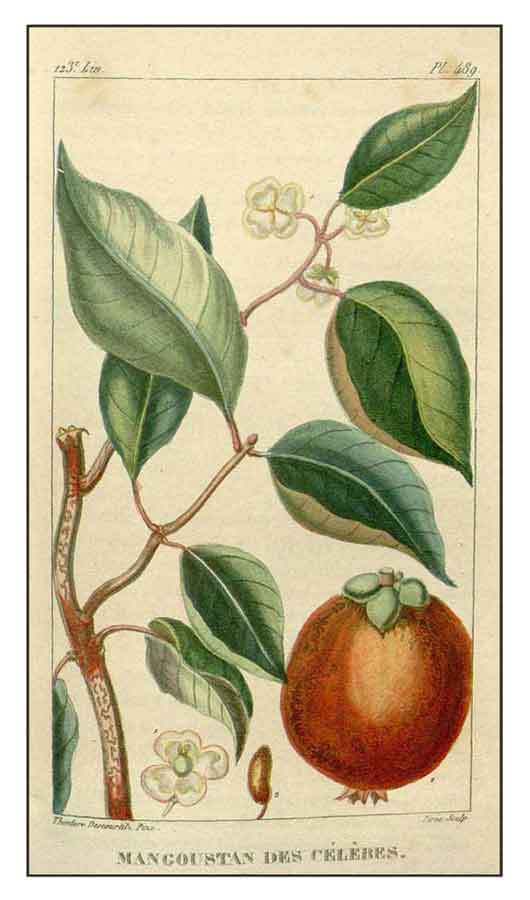 Gen info Gen info
- Etymology: The genus was named in honor of Laurent Garcin (1683-1751), a French botanist. The species epithet likely refers to the Celebes island in Indonesia, now known as Sulawesi, where the type specimen was collected from. (2)
-
The common name Seashore mangosteen refers to its being found near the coast. It looks similar to the cultivated mangosteen (Garcinia mangostana). While the fruits are similar in morphology, Garcinia celebica have pinkish-red fruits with yellow pulp while G. mangostana have dark purple fruits with white pulp. While both fruits are edible, G. celebica are sour while the cultivated mangosteen are sweet. (2)
 Botany Botany
Garcinia celebica is a small to medium evergreen tree that can grow up to 30 m high. Crown is dense and conical. Bark is light brown to dark, fissured and flaky. Tree yields a latex that is white, cream, or yellow. It has a single main trunk, branching monopodially, with a terminal bud at the apex growing upwards, and branches growing out laterally. Petioled or leafstalks are present, while stipules are absent. Leaves are leathery, light to dark green, with the underside lighter than the top; simple opposite, elliptic to oval or lanceolate, entire margins. Leaf base is cuneate to obtuse or acute, while apex is acute to acuminate, with drip tips present. Venation is pinnate, with faint to visible secondary veins branching off from the main central midrib vein. Midrib is raised on both upper and lower surfaces of the leaf. Glandular line are visible on the lower surface of the leaf with closely arranged wavy brown to pale green lines angled at about 45° from the midrib. Flowers are dioecious, male flowers occurring in clusters of 2-18, while female flowers are mostly solitary, sometimes in clusters of 2-3. Flowers are small, with four petals, off-white to creamy-yellow. Sepals are present. Inflorescences are terminal, arranged in a simple cyme. Fruits are simple and fleshy, turning green to pinkish-red when mature; round, with a usually smooth skin, up to 5 cm; exuding an apple-like odor, with an interior similar to mangosteen (G. mangostana) except for the yellowish pulp and sour taste. (2)
 Distribution Distribution
- Native to the Philippines.
- Also native to Andaman Is., Assam, Bangladesh, Bismark Archipelago, Borneo, Cambodia, Jawa, Laos, Lesser Sunda Is., Malaya, Maluku, Myanmar, New Guinea, Nicobar Is., Solomon Is., Sulawesi, Sumatera, Thailand, Vietnam. (1)
- Primarily in wet tropical biomes.
(1)
- On rocky and sandy coasts.
Constituents
- Study of leaves for essential oil by GC and GC-MS yielded 22 compounds, dominated by α-copaene (61.25%), germacrene D (6.72%) and ß-caryophyllene (5.85%). (see study below) (3)
Properties
- Studies have suggest anti-hepatitis C virus, antibacterial, anticancer, anti-neuraminidase, antioxidant, antiplasmodial properties.
Parts used
Roots, leaves, stem bark.
Uses
Edibility
- Fruits are edible, unlike the sweetness of Garcinia mangostana, it has a sour taste.
Folkloric
- No reported folkloric medicinal use in the Philippines.
- In Malaysia, roots and leaves applied itchiness; taken as medicine by women after childbirth. (2)
S tudies tudies
• Anticancer / Antimicrobial / Essential Oil of Leaves: Study evaluated the chemical composition of essential oil from leaves and its cytotoxic and antimicrobial potential. In vitro MTT assay, the EO exhibited significant anti-proliferative effects towards MCF-7 human breast cancer cells with IC50 of 45.2 µg/mL. On antimicrobial testing, it showed better inhibitory effects on gram-positive bacteria than gram-negative with no effect on fungi tested. (see constituents above) (3)
• Antioxidant / Cytotoxicity / Antiplasmodial / Rootbark: Study of rootbark isolated polyprenylated benzophenones (-)-cycloxanthochymol, isoxanthochymol, and xanthocymol. Antioxidant and cytotoxicity evaluation showed all benzophenones exhibited antioxidant activity by DPPH, ABTS, and FRAP methods compared to gallic acid and quercetin as positive control and also exhibited strong activity against HeLa, MCF-7, A549, and B16 cell lines compared to cisplatin as positive control. Antiplasmodial evaluation showed isoxanthochymol exhibited activity against chloroquine-sensitive P. falcifarum strain 3D7. In silico molecular docking study supported the in vitro activities. The isolated benzophenones have potential as oral drug candidates. (4)
• Catechin / Antiplasmodial / Leaves: Study evaluated ethanol extract of leaves and fractions for in vitro antiplasmodial activity against chloroquine-resistant P. falcifarum. The IC50 of (+)-catechin, the characterized compound, against P. falcifarum was 198 µM in 24 hours. The catechin inhibited growth in both trophozoite and schizont stages. Results suggest the antiplasmodial property of catechin was via induction of oxidative stress to P. falcifarum. (5)
• Friedolanostane Triterpenoid / Antiproliferative against Breast Cancer / Leaves: Leaves of Garcinia celebica strongly inhibit the proliferation of MCF-7 human breast adenocarcinoma cell lines. Study evaluated the active anticancer and antiproliferative compound from GC leaves and its mechanism of action. Friedolanostane triterpenoid was isolated. The compound inhibited MCF-7 cell proliferation in a time- and dose-dependent manner with IC50s of 82 and 70 µM in 24 and 48 h treatments. The compound exerted anticancer activities by promoting apoptosis through inhibition of the oncogenic protein Akt, thereby increasing the expression of poly (ADP-ribose) polymerase (PARP) protein. (6)
• Anti-Neuraminidase / Leaves: The neuraminidase enzyme (NA) from the influenza virus is responsible for proliferation and infections of the virus progeny. Study sought to discover a new potential neuraminidase inhbitor from G. celebica leaves. Friedeline, two lanastone derivatives, and catechin were identified. The inhibitory potency of the four compounds on NA from C. perfringens and H1N1 were GC4 > GC2 > GC3 > GC1. All compounds showed higher inhibitory activity towards C. perfringens NA compared to H1N1 NA. In enzyme inhibition study, GC4 showed highest activity with IC50 60.3 µM and 91.0 µM for C. perfringens NA and H1N1 NA, respectively. (7)
• Anti-HCV Activity / Anticancer: Study evaluated the anti-HCV activity of Garcinia celebica against JFH1 strain genotype 2a and anticancer activity against Huh7it-1 cell line. The extract exhibited anti-HIV activity on 1.25 µg/mL. Extracts exhibited anticancer activity on 20, 10, 5, and 2.5 µg/mL with high level of toxicity to Huh7it-1 cells. Results suggest potential as an add-on therapy for treating HCV infections and HCC. (8)
• Antibacterial against E. coli: In a study of antibacterial properties of leaf extracts of 34 primate-consumed plants, the methanol fraction of Garcinia celebica was one of the extracts that showed greatest antibacterial activity against Escherichia coli. (9)
• Anticancer / Macluraxanthone / Bark: Study of bark isolated a new depsidone, garcinisidone H (1) and six novel triterpenoids, along with 12 known compounds. The compounds were tested for cytotoxicity using sulforhodamine B assay against human breast cancer cell line MCF-7, and macluraxanthone exhibited the strongest activity with IC50 of 6.1 µM. (10)
Availability
- Wild-crafted.
- Ornamental cultivation. |

![]()




 Botany
Botany

